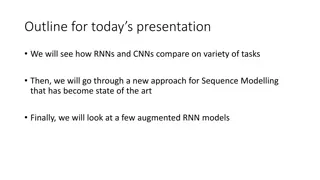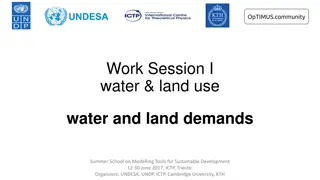Understanding Time Slices in Energy Modelling
Time slices are representative time periods used in long-term energy system models to capture temporal variations in supply and demand, considering factors like seasonality and peak load requirements. Dividing each year into slices helps in detailed analysis with minimal computational cost and efficient representation of data for electricity demand and water resources.
Download Presentation

Please find below an Image/Link to download the presentation.
The content on the website is provided AS IS for your information and personal use only. It may not be sold, licensed, or shared on other websites without obtaining consent from the author. Download presentation by click this link. If you encounter any issues during the download, it is possible that the publisher has removed the file from their server.
E N D
Presentation Transcript
Basics of energy modelling III: Time representation and considerations CLEWS Summer School, ICTP (Trieste), Italy, 13 June, 2017
Time representation Long-term energy system models: Span a large time horizon (e.g. 2015 2050) Consider a large set of technologies Span a large geographical region (e.g. USA, Africa, Europe, China) Need to capture temporal variations: Variability of supply (e.g. wind, solar, hydro) Variability of demand (e.g. seasonal, monthly, weekly, daily) Peak load requirements Trade-off between level of detail and computational cost
What are Time Slices? Each year divided into representative time periods known as Time Slices: (Summer-Winter-Intermediate) x (Day- Night) = 6 Time Slices (Jan-Feb-Mar- -Dec) x (Weekday- Weekend) x (Day-Night) = 48 Time Slices (365 days) x (24 hours) = 8760 Time Slices Number of Time Slices in OSeMOSYS is practically unlimited Time Slice definition is consistently applied for the entire model Electricity demand Water resources 0 8760
Example of Time Slice definition Model horizon Annual 2017 2050 Seasonal Weekly Daily Source: R. Loulou, U. Remne, A. Kanudia, A. Lehtila, and G. Goldstein. Documentation for the TIMES model: Part I. ETSAP, April 2005
Time Slice-related parameters Year Split: Duration of each Time Slice as a fraction of a year Capacity Factor: Fraction of a technology s capacity that can be utilized in each Time Slice Specified Annual Demand*: Fraction of annual demand for a commodity in a each Time Slice *Accumulated Annual Demand: Total annual demand for a commodity. Can be balanced in any Time Slice.
Time Slice Definition (Example cont.) Year divided in four Seasons 1. Season 1: 1st January to 30th April 2. Season 2: 1st May to 31st August 3. Season 3: 1st September to 30th November 4. Season 4: 1st December to 31st December
Time Slice Definition (Example cont.) Season 1 Season 2
Time Slice Definition (Example cont.) Season 3 Season 4
Time Slice Definition: Exercise 1 01:00-07:00 6 hours 07:00-18:00 11 hours 18:00-22:00 4 hours 22:00-01:00 3 hours Seasons Season 1 (Jan-Apr) ? ? ? ? Season 2 (May-Aug) ? ? ? ? Season 3 (Sep-Nov) ? ? ? ? Season 4 (Dec) ? ? ? ?
Time Slice Definition: Exercise 1 Time (duration) 01:00-07:00 07:00-18:00 18:00-22:00 22:00-01:00 Total = 24 hours 6 hours 11 hours 4 hours 3 hours Season 1 (Jan-Apr) 120 days 0.08219 0.15068 0.05479 0.04110 Season 2 (May-Aug) 123 days 0.08425 0.15445 0.05616 0.04212 Season 3 (Sep-Nov) 91 days 0.06233 0.11427 0.04155 0.03116 Season 4 (Dec) 31 days 0.02123 0.03893 0.01416 0.01062 Total = 365 days Total = 8760 hours
Exercise 2: Earlier example, with TimeSlices NOTE: SpecifiedAnnualDemand instead of AccumulatedAnnualDemand YearSplit Day Night 18:00-6:00 12 hours 0.1667 0.1667 0.1667 6:00-18:00 12 hours 0.1667 0.1667 0.1667 Summer Winter Intermediate 4 months 4 months 4 months SpecifiedDemandProfile Day 7:00-19:00 19:00-7:00 12 hours 0.15 0.5 0.15 Night 12 hours Summer Winter Intermediate 4 months 4 months 4 months 0.05 0.1 0.05























